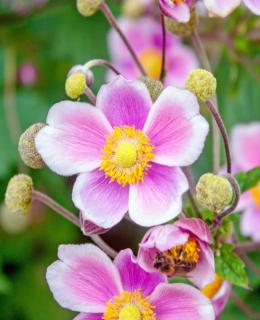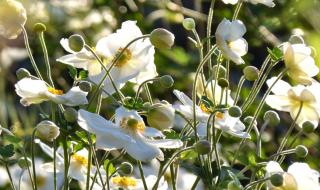

Japanese anemone is a perennial with remarkable fall blooming.
Key Japanese anemone facts
Name – Anemone japonica
Family – Ranunculaceae
Type – tuberous perennial
Height – 5 to 12 inches (5 to 30 cm)
Exposure – full sun, part sun
Soil – ordinary, well drained
Flowering – August to October
Care, from planting to blooming, is easy and the ornamental impact is guaranteed.
Planting Japanese anemone requires light and well drained soil, sun but not too much heat which would tend to burn the leaves.
 From tubers, plant in fall at a depth of 4 inches (10 cm).
From tubers, plant in fall at a depth of 4 inches (10 cm).You must remove wilted flowers regularly (deadheading) in order to boost flower-bearing.
Japanese anemone abominates powdery mildew, that white powder that covers the leaves.
 Japanese anemone is one of the cutest flowers to bloom in fall. Slender and elegant, it bows to the caress of the first autumn gales and decorates our gardens and decks from the end of summer up to the first frost spells.
Japanese anemone is one of the cutest flowers to bloom in fall. Slender and elegant, it bows to the caress of the first autumn gales and decorates our gardens and decks from the end of summer up to the first frost spells.
They are perfect towards the back of perennial beds for the taller species, or along edges and in rocky ground for smaller ones.
Sometimes invasive because it is self-sowing, you won’t have any trouble restraining its growth.
Watch out if you have children around because this plant is poisonous.